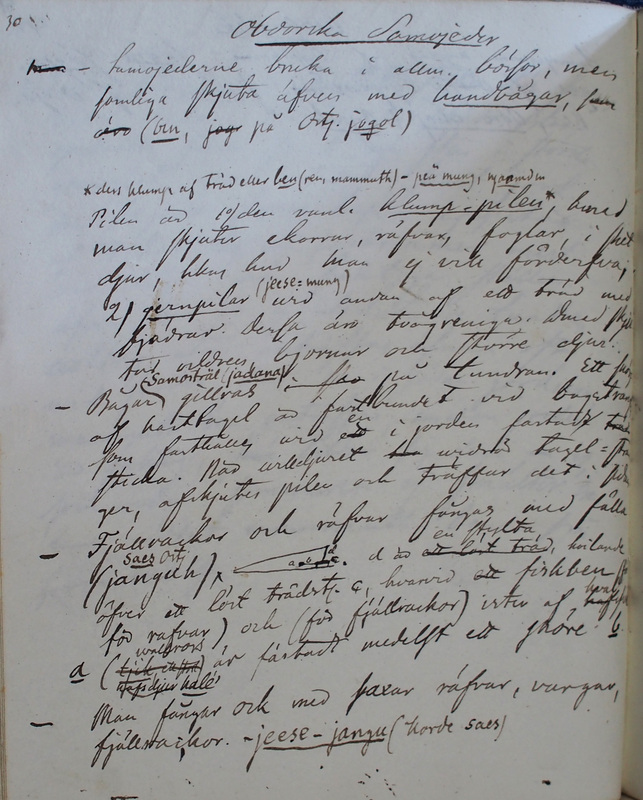Ethnographiska, historiska och statistiska anmärkningar. 030
Title
Ethnographiska, historiska och statistiska anmärkningar. 030
Description
| Obdorska Samojeder Samojederne bruka i allm[änhet]. bössor, men somlinga skjuta äfven med handbågar, som äro (ыn, jog på Ostj. jogol) Pilen är 1) den vanl[igaste]. klump-pilen
TN пя’ муңг literally ʻwooden arrow’, also локы муңг, нямд’ муңг ʻantler arrow’, would be possible, but here, нямд’ refers to an antler or horn. Mammoth tusk would be я’ нямд. One also meets mammoth tusk and bone arrows in folklore (see Kuprijanova 1965: 221, 470, 447, 521).
«ders klump af träd eller ben (ren, mammuth) - peä mung, njaamdm» hvmed[hvarmed] man skjuter ekorrar, räfvar, foglar, i sket[skynnerhet] djur, hkas[hvilkas] hud man ej vill förderfva, 2) jernpilar
(jeese=mung) wid ändan af ett träd medTN еся муңг ʻiron arrow’; also ëхота ʻtwo-branched arrow’.
fjädrar. Dessa äro tvågreniga hdmed[hvarmed] skju- tas vildren, björnar och större djur. |
Obdorsk Samoyeds All the Samoyeds use guns, but some also shoot with bows (TN ыn, in Ostyak jogol). The arrow is 1) «mainly blunt-headed (made from wood bone (reindeer, mammoth) - peä mung, njaamdm),» used for shooting squirrels, foxes, or birds, especially animals whose skin one does not want to spoil, or 2) iron arrows (jeese mung) with a head made from wood with feathers. These are two-headed; wild reindeer, bears, and bigger animals are shot with them. |
| Bågar gillras (Samosträl
jadana)
på tundran. Ett snöreTN яданана ‘crossbow, arbalest’.
af hästtagel är fastbundet vid bågsträng, som fasthålles vid en i jorden fastad sticka. När villdjuret widrör tagel-strån- ger, afskjutes pilen och träffar det i sidan. |
Bows are set up (crossbow, jadana) in the tundra. A string made of horsehair is tied to the bowstring which is held by a stick fastened in the ground. When a wild animal touches the horsehair, the arrow is fired and hits it in the side. |
| Fjällrackor och räfvar fångas med fälla (janguh;
saes Ostj.)
TN яңго ʻtrap’. The leter refers to the picture in the text.
d
är ett lågt träden stylta, hvilande The letter refers to the drawing on the manuscript page.
öfver ett löst trädst[ycke]. c,
hvarvid en fiskben (förThe letter refers to the drawing on the manuscript page.
rafvar) och (för fjällrackor) ister af hafsfiske a
(walross; hafsdjur halé') är fästad medelst ett snöre
The letter refers to the drawing on the manuscript page.
b.
The letters refers to the drawing on the manuscript page.
|
Arctic foxes and foxes are caught with traps (TN janguh; Ostyak saes) In the figure, d is a wooden stilt resting over a loose piece of tree c, whereby a fishbone (for foxes) and (for Arctic foxes) the fat of a sea fish or walrus a (walrus; sea animal halé') is attached with a string b. |
| Man fångar ock med saxar räfvar, vargar, fjällrackor. - jeese-jangu
(Korde saes)TN еся яңго ‘foothold trap’ literally ʻiron trap’. [See also ijenguh].
|
Foxes, wolves, and Arctic foxes are also caught with foothold traps – jees-jangu (Korde saes) |

